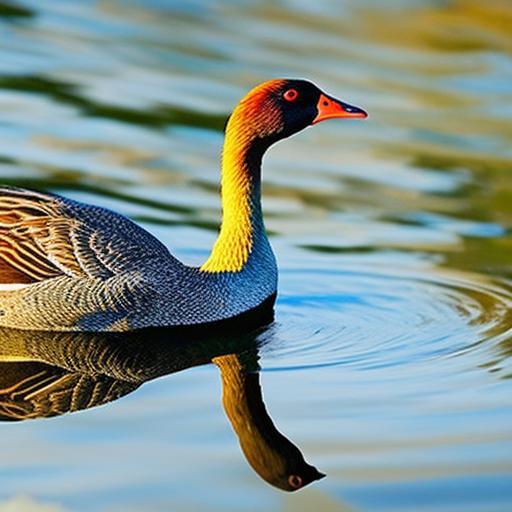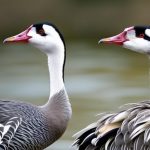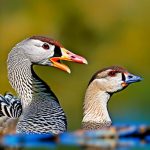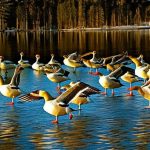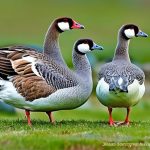Geese invading ponds and causing damage is a common problem faced by many pond owners. These birds can be a nuisance as they leave behind droppings that can contaminate the water and surrounding areas. Additionally, their constant presence can scare away other wildlife and disrupt the peaceful environment of the pond. Fortunately, there are various methods that can be used to deter geese and keep them away from ponds.
Key Takeaways
- Geese are attracted to open water and lush vegetation near ponds.
- Physical barriers like fences and netting can prevent geese from accessing ponds.
- Pond covers can also be effective in keeping geese away.
- Sound and motion deterrents like decoys and noise makers can scare geese away.
- Removing attractive food sources and modifying the habitat can discourage geese from staying.
Understanding the Behavior of Geese
Geese are attracted to ponds for several reasons. Firstly, ponds provide a source of water for drinking and bathing, which is essential for their survival. Secondly, ponds often have lush vegetation around them, which serves as a food source for geese. Lastly, ponds offer a safe and open space for geese to rest and socialize.
The behavior of geese plays a significant role in their interaction with ponds. Geese are social animals that prefer to stay in groups or flocks. They have a strong sense of territory and will defend their chosen area from other geese. When geese find a suitable pond, they will often return to it repeatedly, making it difficult to deter them.
Creating a Physical Barrier
One effective method to keep geese away from ponds is by creating a physical barrier. There are different types of barriers that can be used, such as fences, netting, or floating barriers.
Fences can be installed around the perimeter of the pond to prevent geese from accessing it. However, fences need to be at least three feet high to be effective, as geese are capable of flying over lower fences. Additionally, fences may not be aesthetically pleasing and can obstruct the view of the pond.
Netting is another option that can be used to cover the entire pond or specific areas where geese tend to gather. The netting should be securely fastened to prevent geese from getting underneath it. However, netting can be time-consuming to install and may require regular maintenance to ensure it remains effective.
Floating barriers are another option that can be used to deter geese. These barriers are placed on the surface of the water and create an obstacle for geese to land or swim. Floating barriers can be made from materials such as ropes, buoys, or floating plants. However, floating barriers may not be effective if the geese are determined enough to find a way around them.
Installing a Pond Cover
Using a pond cover is another effective method to keep geese away from ponds. Pond covers can be made from materials such as mesh or netting and are placed over the entire pond or specific areas where geese tend to gather.
Pond covers provide a physical barrier that prevents geese from accessing the water. They also help to keep the water clean by preventing debris from falling into the pond. Additionally, pond covers can help to maintain a stable water temperature and prevent excessive evaporation.
There are different types of pond covers available, such as rigid covers or flexible covers. Rigid covers are made from materials such as metal or plastic and provide a sturdy barrier. Flexible covers, on the other hand, are made from materials such as mesh or netting and can be easily removed when needed.
Utilizing Sound and Motion Deterrents
Sound and motion deterrents can be used to scare geese away from ponds. These deterrents work by creating a sense of danger or discomfort for the geese, causing them to leave the area.
One type of sound deterrent is a sonic device that emits loud noises or predator calls. These devices can be placed around the pond and programmed to activate at specific times or when motion is detected. The loud noises or predator calls mimic natural sounds that would scare geese away.
Another type of sound deterrent is a water cannon or sprinkler system that activates when geese approach the pond. The sudden burst of water startles the geese and encourages them to leave the area. These systems can be set on timers or activated manually.
Motion deterrents, such as scarecrows or decoys, can also be effective in deterring geese. Scarecrows are life-sized figures that resemble predators, such as owls or coyotes. Decoys are replicas of geese or other waterfowl species. Both scarecrows and decoys create a visual deterrent that scares geese away.
Implementing Scare Tactics
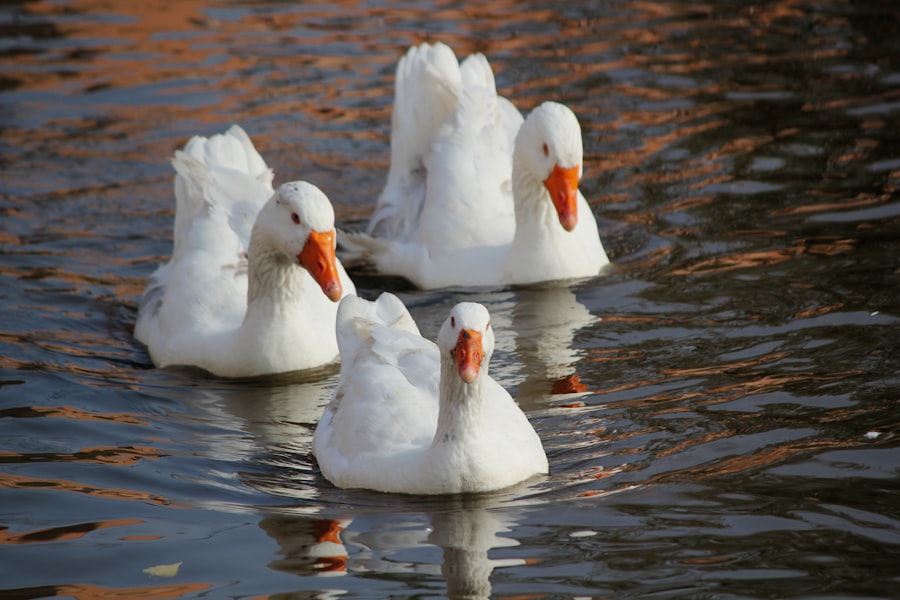
Scare tactics can be used to keep geese away from ponds. These tactics work by creating a sense of fear or discomfort for the geese, making them avoid the area.
One common scare tactic is the use of pyrotechnics or loud noises to startle the geese. This can be done by using devices such as air cannons or firecrackers. The sudden loud noises scare the geese and encourage them to leave the area.
Another scare tactic is the use of visual deterrents, such as reflective tape or flags. These items create movement and reflect light, which can startle the geese and make them feel uncomfortable. Visual deterrents should be placed strategically around the pond to maximize their effectiveness.
Removing Attractive Food Sources
Geese are attracted to ponds because they provide a source of food. To discourage geese from coming to the pond, it is important to remove these attractive food sources.
One common food source for geese is grass or vegetation around the pond. Regularly mowing the grass and removing any fallen leaves or debris can help to discourage geese from coming to the pond. Additionally, planting less attractive vegetation or using plants that are unpalatable to geese can also be effective.
Another food source for geese is human-provided food, such as bread or other scraps. It is important to educate visitors or nearby residents about the negative effects of feeding geese and discourage them from doing so. Additionally, removing any food sources that may be left behind, such as garbage or pet food, can also help to deter geese.
Implementing Habitat Modification
Habitat modification can be done to discourage geese from coming to the pond. This involves making changes to the surrounding environment to make it less attractive or suitable for geese.
One method of habitat modification is the use of vegetation barriers. Planting tall grasses or shrubs around the pond can create a physical barrier that makes it difficult for geese to access the water. Additionally, these barriers can provide nesting areas for other wildlife and enhance the overall biodiversity of the pond.
Another method of habitat modification is the use of deterrent plants. Certain plants, such as prickly shrubs or plants with strong odors, are unpalatable to geese and can deter them from coming to the pond. These plants should be strategically placed around the pond to maximize their effectiveness.
Using Repellents and Chemicals
Repellents and chemicals can be used to keep geese away from ponds. These products work by creating an unpleasant or uncomfortable environment for the geese.
One type of repellent is a taste deterrent that is applied to the grass or vegetation around the pond. These repellents have a bitter taste that is unappealing to geese and discourages them from feeding on the vegetation. Taste deterrents should be applied regularly and after rainfall to remain effective.
Another type of repellent is a visual deterrent that is sprayed on surfaces around the pond. These repellents create a shiny or reflective surface that scares geese away. Visual deterrents should be applied strategically around the pond to maximize their effectiveness.
Seeking Professional Assistance
If all else fails, it may be necessary to seek professional assistance to deal with geese problems. There are different types of professionals that can be hired, such as wildlife control experts or pond management companies.
Wildlife control experts specialize in dealing with nuisance wildlife, including geese. They have the knowledge and experience to implement effective deterrent methods and can provide advice on long-term solutions.
Pond management companies specialize in maintaining and managing ponds. They can provide services such as pond cleaning, vegetation management, and water quality testing. By maintaining a clean and healthy pond environment, the likelihood of geese being attracted to the pond is reduced.
Maintaining a Clean and Healthy Pond Environment
One of the most important steps in deterring geese from ponds is maintaining a clean and healthy pond environment. Geese are attracted to ponds that provide suitable conditions for their survival, such as clean water and abundant food sources.
Regularly cleaning the pond and removing any debris or fallen leaves can help to maintain water quality and discourage geese from coming to the pond. Additionally, monitoring and managing the vegetation around the pond can help to prevent overgrowth and reduce the availability of food sources for geese.
It is also important to monitor water quality and address any issues that may arise. Poor water quality can lead to an increase in algae or other aquatic plants, which can attract geese. Regular testing and treatment of the water can help to maintain a healthy pond environment.
In conclusion, there are various methods that can be used to deter geese from ponds. These methods include creating physical barriers, installing pond covers, utilizing sound and motion deterrents, implementing scare tactics, removing attractive food sources, implementing habitat modification, using repellents and chemicals, seeking professional assistance, and maintaining a clean and healthy pond environment. By taking action to keep geese away from ponds, pond owners can maintain a peaceful and enjoyable environment for themselves and other wildlife.
If you’re looking for effective ways to keep geese out of your pond, you might also be interested in learning about the benefits of keeping guinea fowl with chickens. Guinea fowl are known for their ability to deter pests and predators, including geese. In a related article on Poultry Wizard, you can discover more about whether guinea fowl can live harmoniously with chickens. To find out how these unique birds can help protect your pond and enhance your poultry flock, check out the article here.
FAQs
What are some common problems caused by geese in ponds?
Geese can cause a number of problems in ponds, including excessive algae growth, water pollution, and damage to pond vegetation.
Why do geese like to swim in ponds?
Geese are attracted to ponds because they provide a source of food, water, and shelter. Ponds also offer a safe place for geese to rest and raise their young.
What are some effective ways to keep geese out of a pond?
Some effective ways to keep geese out of a pond include installing fencing or netting around the pond, using decoys or scare devices, and planting vegetation that geese find unappealing.
Is it legal to harm or kill geese to keep them out of a pond?
In most cases, it is illegal to harm or kill geese without a permit. It is important to check with local wildlife authorities before taking any action to deter geese from a pond.
What are some natural ways to discourage geese from using a pond?
Some natural ways to discourage geese from using a pond include planting vegetation that geese find unappealing, using floating islands to disrupt their habitat, and introducing natural predators like foxes or coyotes.
Meet Walter, the feathered-friend fanatic of Florida! Nestled in the sunshine state, Walter struts through life with his feathered companions, clucking his way to happiness. With a coop that’s fancier than a five-star hotel, he’s the Don Juan of the chicken world. When he’s not teaching his hens to do the cha-cha, you’ll find him in a heated debate with his prized rooster, Sir Clucks-a-Lot. Walter’s poultry passion is no yolk; he’s the sunny-side-up guy you never knew you needed in your flock of friends!

